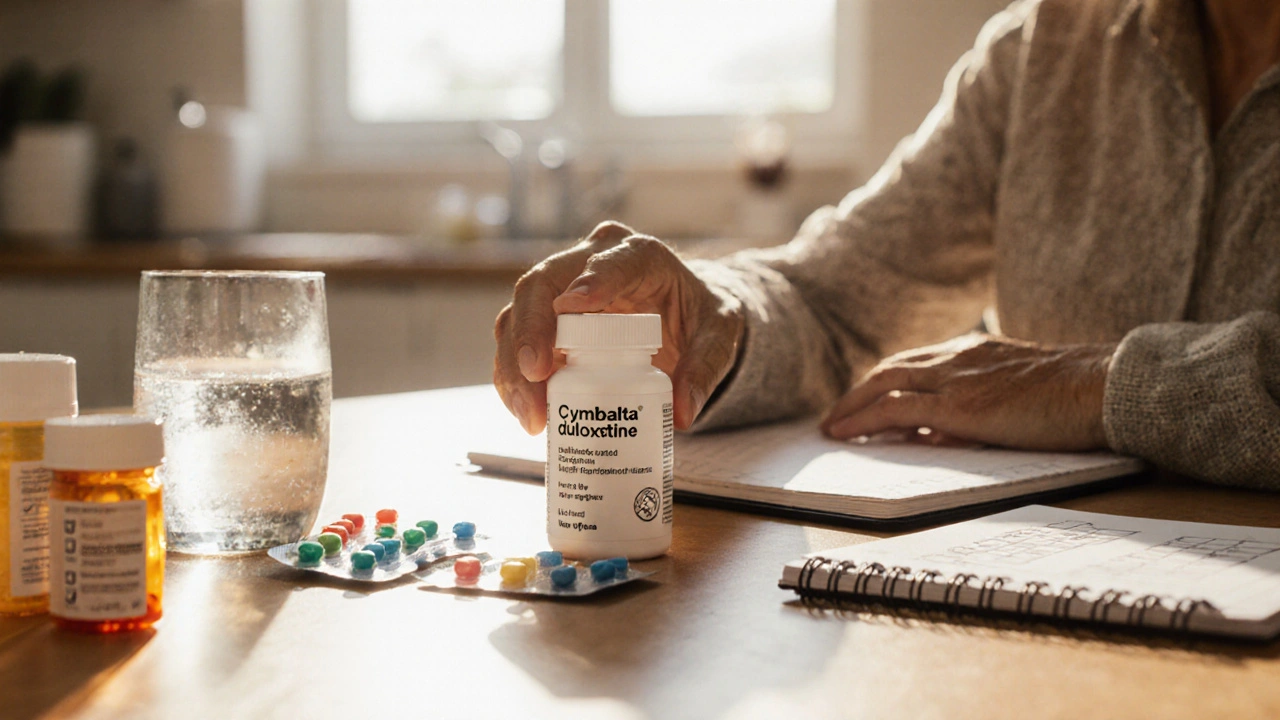Cymbalta vs. Alternatives: Medication Comparison Tool
This tool compares Cymbalta (duloxetine) with common alternative medications for depression, anxiety, and chronic pain. Select a condition to see which medications may be most suitable.
Cymbalta (Duloxetine)
Class: SNRI
Uses: Depression, Anxiety, Fibromyalgia, Diabetic Neuropathy, Chronic Pain
Dosage: 30–120 mg daily
Side Effects:
Nausea
Dry Mouth
Dizziness
Elevated BP
Sertraline (Zoloft)
Class: SSRI
Uses: Depression, Anxiety, PTSD, OCD
Dosage: 50–200 mg daily
Side Effects:
Nausea
Headache
Sexual Dysfunction
Venlafaxine (Effexor)
Class: SNRI
Uses: Depression, Anxiety, Panic Disorder
Dosage: 75–375 mg daily
Side Effects:
Nausea
Dizziness
Elevated BP
Bupropion (Wellbutrin)
Class: NDRI
Uses: Depression, ADHD, Smoking Cessation
Dosage: 150–450 mg daily
Side Effects:
Insomnia
Weight Loss
Lower Sexual Dysfunction Risk
Amitriptyline
Class: TCA
Uses: Neuropathic Pain, Depression, Sleep Aid
Dosage: 25–150 mg nightly
Side Effects:
Sedation
Dry Mouth
Constipation
Escitalopram (Lexapro)
Class: SSRI
Uses: Depression, Anxiety, GAD
Dosage: 5–20 mg daily
Side Effects:
Nausea
Sexual Dysfunction
Minimal Interactions
How to Use This Tool:
Select a condition from the dropdown to filter medications. Each card shows key information including class, uses, dosage range, and major side effects. This comparison helps you and your healthcare provider make informed decisions about medication selection.
Note: Always consult with a healthcare provider before starting or changing any medication regimen.
When you or a loved one need relief from depression, anxiety, or chronic pain, the first question is often: which pill works best? Cymbalta has become a household name, but it’s far from the only option. This guide breaks down how Cymbalta (duloxetine) measures up against other commonly prescribed drugs, highlighting why one might be a better fit based on condition, side‑effect tolerance, and lifestyle.
Key Takeaways
- Cymbalta is an SNRI that treats depression, anxiety, fibromyalgia, diabetic neuropathy, and chronic musculoskeletal pain.
- SSRI alternatives (sertraline, escitalopram) excel in pure depression/anxiety with fewer pain‑related side effects.
- Venlafaxine offers a dose‑dependent switch from SSRI‑like to SNRI‑like activity.
- Bupropion is a norepinephrine‑dopamine reuptake inhibitor (NDRI) useful for patients worried about sexual dysfunction.
- Amitriptyline, a TCA, remains a low‑cost option for neuropathic pain despite higher side‑effect risk.
What Is Cymbalta (Duloxetine)?
Cymbalta is a prescription medication whose active ingredient is duloxetine, a serotonin‑norepinephrine reuptake inhibitor (SNRI). It was approved by the FDA in 2004 for major depressive disorder (MDD) and generalized anxiety disorder (GAD), later expanding to include fibromyalgia, diabetic peripheral neuropathy, and chronic musculoskeletal pain. By blocking the reuptake of both serotonin and norepinephrine, Cymbalta boosts mood‑lifting and pain‑modulating pathways simultaneously.
Typical dosing starts at 30mg once daily, often increased to 60mg for depression or anxiety. For pain indications, clinicians may go up to 120mg daily, split into two doses. The drug’s half‑life of about 12hours allows once‑or‑twice‑daily regimens, and therapeutic effects generally appear within 2‑4 weeks for mood, 4‑6 weeks for pain relief.
Why Look at Alternatives?
Even though Cymbalta covers a wide range of symptoms, it isn’t suitable for everyone. Common side effects-nausea, dry mouth, dizziness, and elevated blood pressure-can be deal‑breakers. Drug interactions with MAO inhibitors, certain antihypertensives, or other serotonergic agents also limit its use. Moreover, insurance formularies sometimes prefer older or cheaper drugs. Understanding the trade‑offs helps you or your clinician pick the safest, most effective option.
Major Competing Medications
Below are the primary alternatives that doctors consider when Cymbalta isn’t the first choice.
- Sertraline is an SSRI (selective serotonin reuptake inhibitor) that treats depression, anxiety, PTSD, and OCD. It’s known for a relatively mild side‑effect profile and low cost.
- Escitalopram is another SSRI, prized for its once‑daily dosing and minimal drug‑interaction risk, often prescribed for MDD and GAD.
- Venlafaxine is a serotonin‑norepinephrine reuptake inhibitor that behaves like an SSRI at low doses (<150mg) and like a stronger SNRI at higher doses (≥225mg). It’s FDA‑approved for depression, GAD, panic disorder, and social anxiety.
- Bupropion is an NDRI (norepinephrine‑dopamine reuptake inhibitor) used for depression, smoking cessation, and ADHD. It avoids sexual side effects common with SSRIs/SNRIs.
- Amitriptyline is a tricyclic antidepressant (TCA) that treats depression and chronic neuropathic pain. It’s cheap but carries anticholinergic side effects.
How the Drugs Stack Up: Comparison Table
| Medication | Class | FDA‑approved uses | Common side effects | Typical dose range | Onset of action |
|---|---|---|---|---|---|
| Cymbalta (Duloxetine) | SNRI | Depression, Anxiety, Fibromyalgia, Diabetic neuropathy, Chronic musculoskeletal pain | Nausea, dry mouth, dizziness, insomnia, increased blood pressure | 30‑120mg daily (usually 60‑120mg for pain) | 2‑4weeks (mood), 4‑6weeks (pain) |
| Sertraline | SSRI | Depression, Anxiety, PTSD, OCD | GI upset, sexual dysfunction, insomnia | 50‑200mg daily | 1‑3weeks |
| Escitalopram | SSRI | Depression, Anxiety | Nausea, fatigue, sexual dysfunction | 10‑20mg daily | 1‑2weeks |
| Venlafaxine | SNRI (dose‑dependent) | Depression, Anxiety, Panic disorder, Social anxiety | Hypertension, nausea, insomnia, sexual dysfunction | 37.5‑225mg daily (extended‑release) | 2‑4weeks |
| Bupropion | NDRI | Depression, Smoking cessation, ADHD | Insomnia, dry mouth, seizures (high dose) | 150‑450mg daily (split dosing) | 1‑2weeks |
| Amitriptyline | TCA | Depression, Neuropathic pain, Migraine prophylaxis | Weight gain, constipation, sedation, cardiac arrhythmia | 25‑150mg daily (usually at night) | 2‑4weeks |
When Cymbalta Is the Right Choice
If a patient has both mood symptoms and chronic pain, Cymbalta’s dual mechanism often outweighs the added risk of blood‑pressure changes. Clinical trials show a 30‑35% improvement in both depressive scores (HAM‑D) and pain scales (Brief Pain Inventory) for patients with fibromyalgia who stay on a 60‑120mg dose. For diabetic neuropathy, a landmark 2011 study found duloxetine reduced average pain by 2.1 points on a 0‑10 scale versus placebo.
Key patient profiles that benefit most:
- Adults with major depressive disorder plus fibromyalgia.
- Patients with generalized anxiety disorder who also report chronic back pain.
- Individuals already on NSAIDs who need an opioid‑sparing option.
In these groups, the convenience of one pill for both issues can improve adherence.
When an Alternative Beats Cymbalta
Several scenarios tip the scales toward other drugs:
- Sexual dysfunction concerns: Both SSRIs and SNRIs can lower libido. Bupropion, lacking serotonergic activity, usually preserves sexual function.
- Hypertension or cardiovascular risk: Venlafaxine and Cymbalta can raise blood pressure, especially at higher doses. Sertraline or escitalopram have minimal impact on BP.
- History of seizures: Bupropion’s seizure risk rises sharply above 450mg daily, so clinicians avoid it in patients with known seizure disorders, choosing sertraline or duloxetine instead.
- Cost sensitivity: Generic sertraline, escitalopram, and bupropion are often cheaper than brand‑name Cymbalta, even after generic duloxetine entered the market in 2022.
- Elderly patients with anticholinergic burden: Amitriptyline’s strong anticholinergic effects can cause confusion, falls, and urinary retention. An SSRI or low‑dose SNRI is safer.
Side‑Effect Management Tips
Regardless of the chosen medication, proactive strategies reduce dropout rates:
- Start low, go slow: Initiate at the lowest effective dose; for Cymbalta, 30mg daily for the first week can lessen nausea.
- Take with food: Most SNRIs and SSRIs cause less GI upset when taken with a meal.
- Monitor blood pressure: Check weekly for the first month if using Cymbalta, venlafaxine, or any high‑dose SNRI.
- Address insomnia: If a medication causes early‑night wakefulness, switch to a morning dose or add a low‑dose melatonin.
- Consider supplementing with lifestyle changes: Exercise, CBT, and adequate sleep enhance medication response across the board.

Decision‑Making Flowchart (Text Version)
Use this quick mental checklist when discussing options with a clinician:
- Do you need pain relief and mood improvement? → Consider Cymbalta or Venlafaxine (higher dose).
- Is sexual function a priority? → Lean toward Bupropion or an SSRI with lower sexual side‑effect rates (e.g., escitalopram may be milder).
- Do you have hypertension? → Prefer sertraline or escitalopram; avoid high‑dose Cymbalta/venlafaxine.
- Are you over 65 with memory concerns? → Avoid Amitriptyline; choose an SSRI or low‑dose SNRI.
- Is cost the main barrier? → Check generic sertraline, escitalopram, or bupropion pricing; generic duloxetine may also be affordable now.
Real‑World Patient Stories (Illustrative)
Case 1 - Sarah, 34, fibromyalgia & depression: After failing an SSRI, her doctor prescribed Cymbalta 60mg. Within three weeks, her PHQ‑9 score dropped from 16 to 8, and her pain rating fell from 7/10 to 4/10. She reports mild nausea that resolved after two weeks.
Case 2 - Mark, 58, hypertension & anxiety: Mark tried Cymbalta but his systolic pressure climbed to 150mmHg. He switched to sertraline 100mg and his BP stabilized, while his GAD‑7 score improved from 14 to 6 over a month.
Case 3 - Lina, 27, desire to quit smoking: Lina needed an antidepressant that wouldn't interfere with nicotine patches. Her clinician chose bupropion SR 150mg BID, which helped her mood and reduced cravings without sexual side effects. She never needed an SNRI.
Bottom Line: Tailor the Choice to the Person
There’s no universal “best” pill. The right medication balances efficacy for the primary condition, tolerability, comorbidities, and personal priorities. Cymbalta shines when mood and pain co‑exist, but alternatives like sertraline, escitalopram, venlafaxine, bupropion, and amitriptyline each have niche strengths that can outweigh Cymbalta’s convenience.
Always discuss your full medical history, current meds, and lifestyle goals with a healthcare professional before starting or switching. A shared decision‑making approach ensures you end up with a treatment plan that feels right for you.
Frequently Asked Questions
Can I take Cymbalta with other antidepressants?
Mixing Cymbalta with another serotonergic drug (another SSRI, SNRI, or MAOI) raises the risk of serotonin syndrome, a potentially life‑threatening condition. Doctors may add a low‑dose atypical antipsychotic for augmentation, but they usually avoid direct antidepressant combos.
Is Cymbalta safe during pregnancy?
Data are limited, and Cymbalta is classified as Pregnancy Category C. It should only be used if the potential benefit outweighs potential fetal risk. Many clinicians prefer SSRIs like sertraline when treating pregnant patients.
How long should I stay on Cymbalta for chronic pain?
Guidelines suggest a minimum of 12 weeks to assess true pain‑relief benefits. If significant improvement occurs and side effects are manageable, many patients continue long‑term, with periodic reassessments every 6‑12 months.
What should I do if I miss a dose of Cymbalta?
Take the missed dose as soon as you remember, unless it’s almost time for the next dose. In that case, skip the missed one-don’t double up, because higher peaks can increase nausea and blood‑pressure spikes.
Are there natural alternatives to Cymbalta for pain?
Exercise, cognitive‑behavioral therapy, omega‑3 supplements, and mindfulness‑based stress reduction have modest evidence for fibromyalgia and neuropathic pain. They can complement or, in some cases, replace medication when side effects are intolerable.


Written by Felix Greendale
View all posts by: Felix Greendale